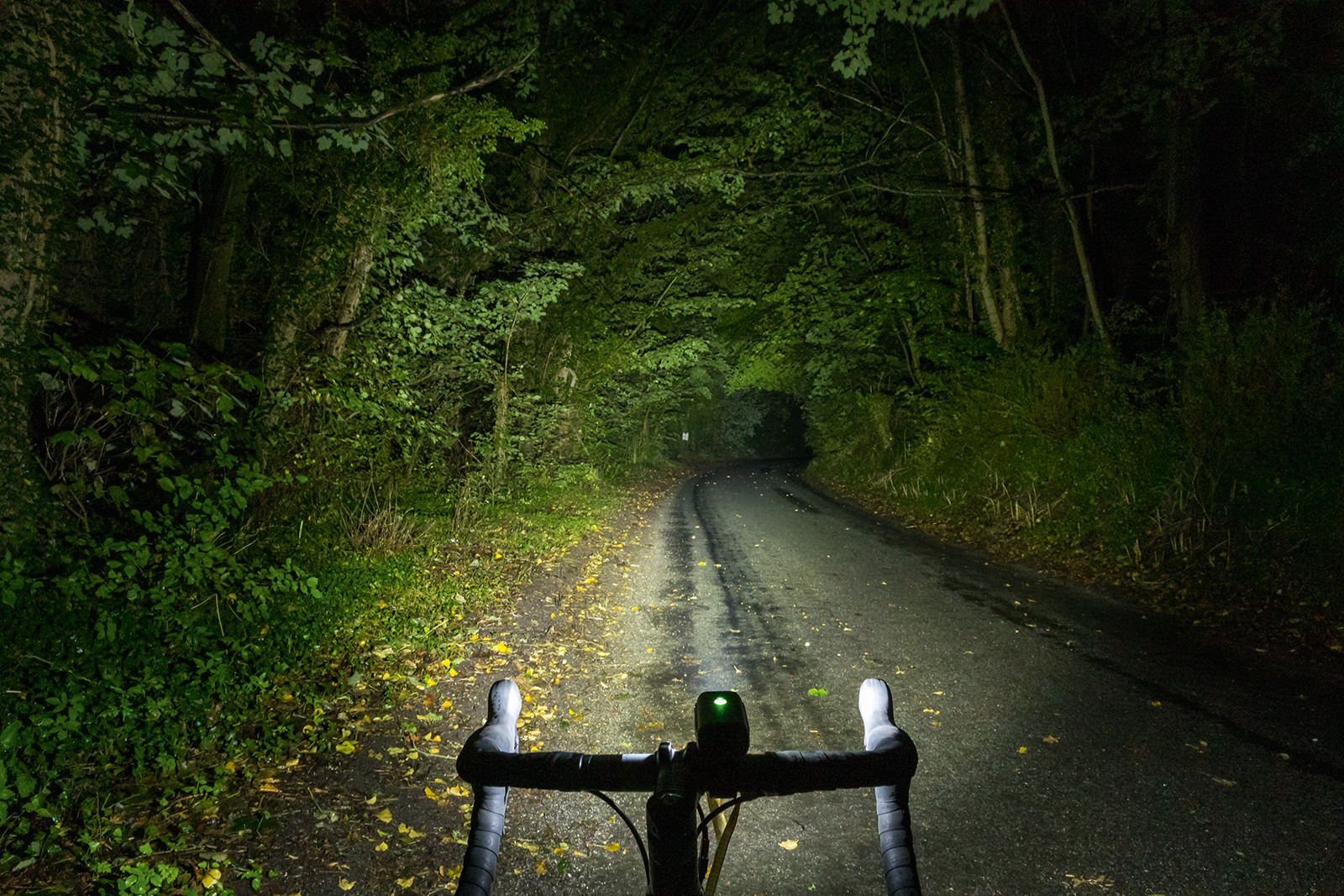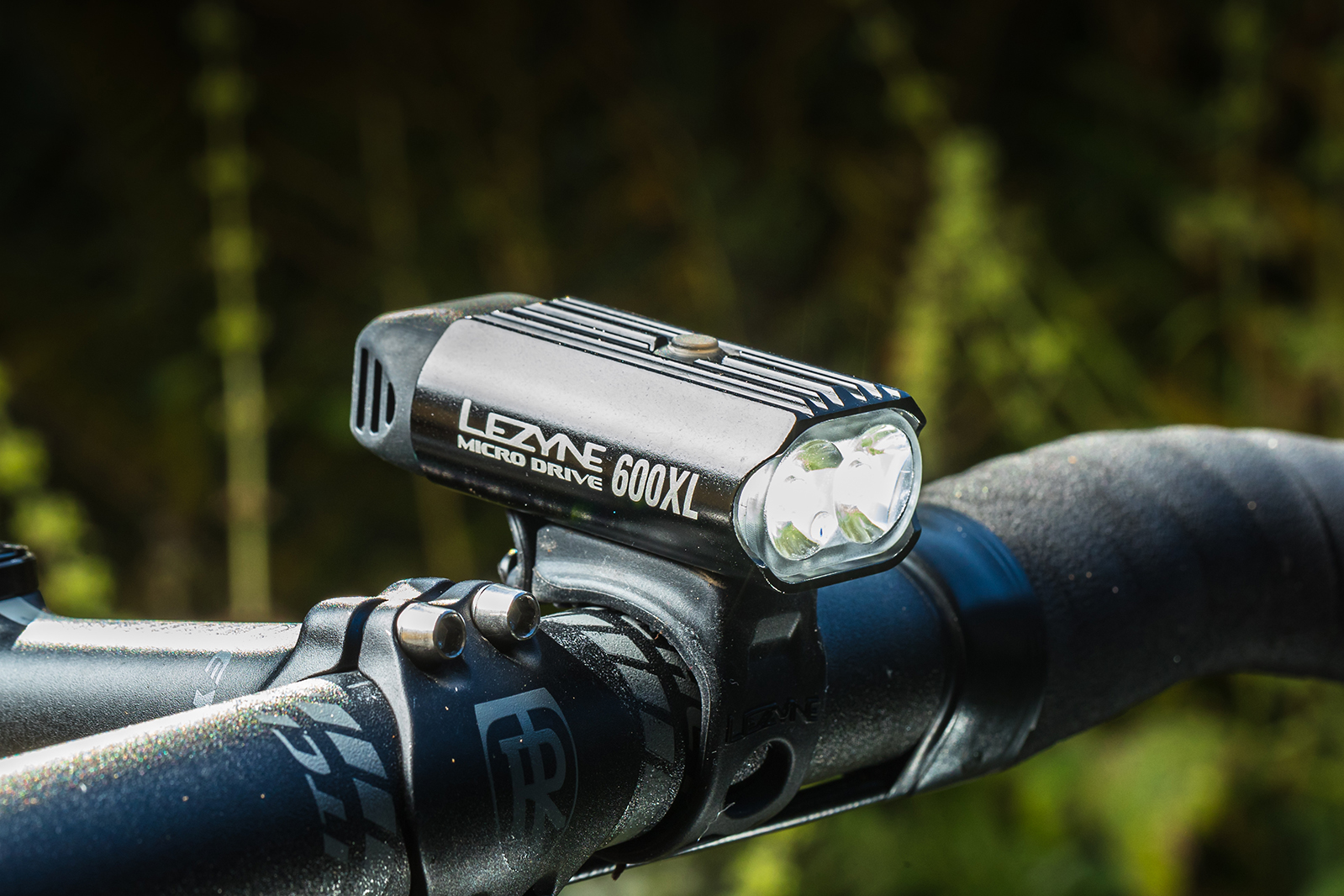A set of the best bike lights should be one of the first cycling accessories on your shopping list. Needless to say, they are essential when cycling at night or if visibility is poor, making lights a must-have during the winter and a smart addition to your bike even in the summer.
It’s a legal requirement in the United Kingdom to have lights on your bike if you’re cycling after sunset (we’ve got a full guide on bike light laws), but some riders like to use them during the day as well, especially during the winter, in order to increase visibility to other road users.
Our expert reviewers have tested dozens of light sets to bring you the definitive list of what we believe are the best road and commuting lights on the market.
Check out our separate round-up of the best mountain bike lights if you’re after lights for riding off-road on trails.
You can also jump to our buyer’s guide to lights for more information on lights, from lumen output to beam width.
Best bike lights at a glance
Here’s BikeRadar’s pick of the best front lights, best rear lights and the best light sets we’ve tested. Read on for more options.
Best front light for under £150 or $200: Bontrager Ion Pro RT
Best front light for under £100 or $150: Lezyne Macro Drive 1400
Best front light for under £60 or $70: Halfords Advanced 1600 lumen
Best front light for under £40 or $60: Lezyne Hecto Drive 500XL
Best rear light: Exposure TraceR DayBright rear light
Best front & rear light set: Bontrager Ion 200 RT and Flare RT
Best front lights for bikes in 2023 as rated by our expert testers
Bontrager Ion Pro RT
- Claimed max output: 1,300 lumens
- Run time (max power): 1 hour 30 minutes
- Pros: Warm-coloured and well-shaped beam; Bluetooth compatibility
- Cons: No lateral adjustment
Bontrager’s Ion Pro RT strikes an excellent balance between a high lumen output and a consistent, pleasingly coloured and well-focused beam pattern.
The clamp is super easy to use and – while its real-world usefulness is questionable – the Bluetooth integration, which allows you to control the light via a Garmin or Di2 shifter, is fun. It’s also simple to operate.
Lezyne Hecto Drive 500XL

- Claimed max output: 500 lumens
- Run time (max power): 1 hour
- Pros: Eight modes; compact with a simple mount
- Cons: Short run time at max power
The Lezyne Hecto Drive XL’s 500 lumens is enough for a decent pace on unlit bike paths, though with only one hour of run time at maximum output, the Hecto is best for use as an urban light.
It charges quickly, stays in the mode you last used it in (surprisingly handy) and offers a total of eight flashing and constant modes, with claimed run times of between one and 20 hours.
The Hecto is also a compact unit with a simple rubber band to strap it to your handlebar.
Lezyne Macro Drive 1400
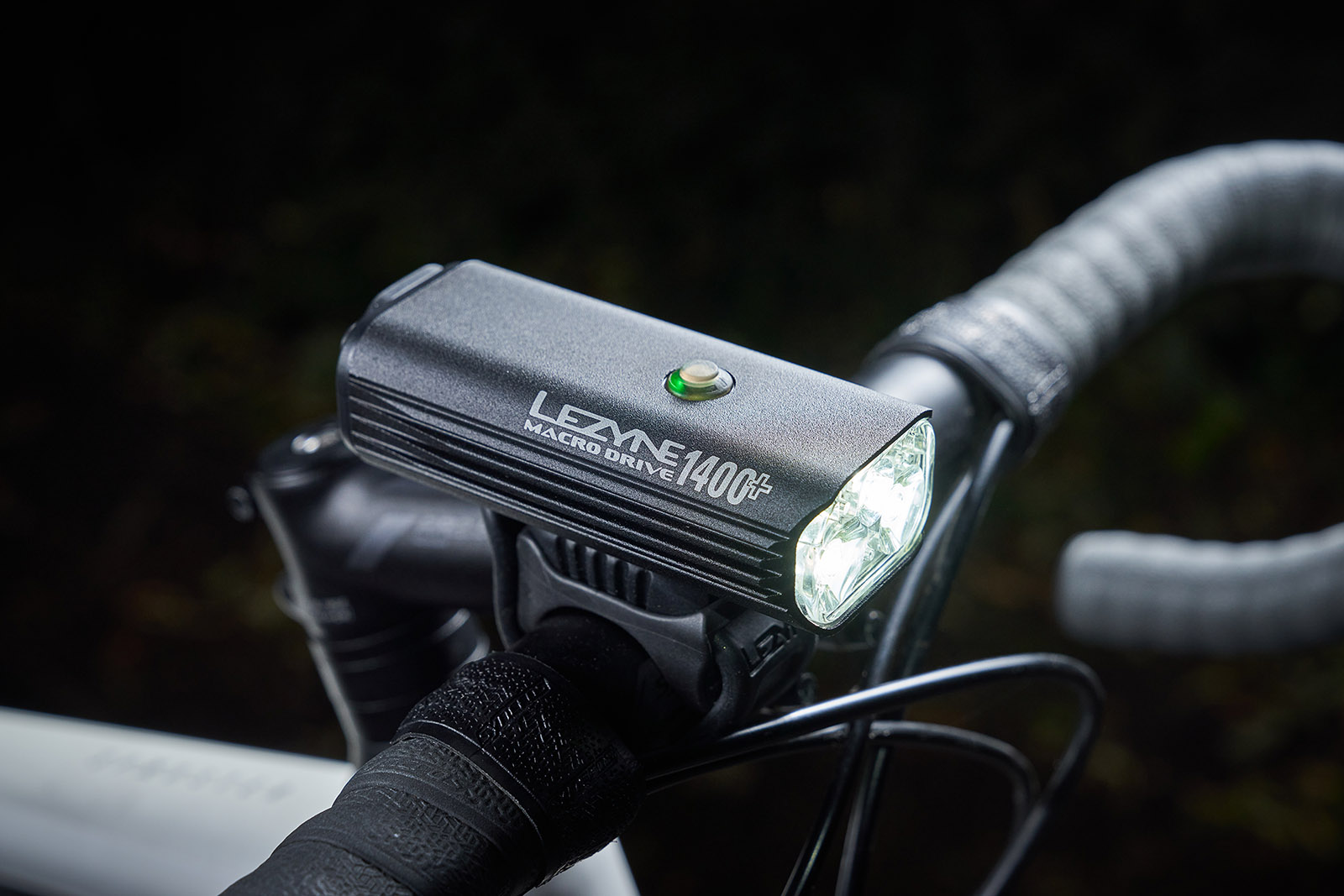
- Claimed max output: 1,400 lumens
- Run time (max power): 3 hours
- Pros: High output for a long time; robust build
- Cons: Few functions compared to competitors
The Lezyne Macro Drive 1400 offers good run times in a compact, robust build.
The light beam has a central focus, illuminating roads well, and the peripheral illumination helps you see what’s at the edge of your vision.
It charges with a USB-C port and while it’s not as feature-rich as some competitors, it packs a powerful punch.
Magicshine Ray 2600B Smart Remote Bike Light

- Claimed max output: 2,600 lumens
- Run time (max power): 1 hour 15 minutes
- Pros: Good run time; bright enough for trails; handlebar remote
- Cons: Glitchy app; no mode indicator
The Magicshine Ray 2600B Smart Remote Bike Light is powerful, with auto-dimming tech and a dual-beam pattern forming a great light for night riding at a competitive price.
It could be considered a gravel bike light, with enough power to illuminate gravel tracks.
The light packs in a lot of tech. You can pair it with a slightly glitchy app to unlock various features and customise the modes. There is also a remote control you can mount to your handlebar for quick changes to brightness.
Exposure Race Mk17

- Claimed max output: 1,700 lumens (on Reflex mode)
- Run time (max power): 2hr
- Pros: Build quality; beam pattern; battery life
- Cons: Fiddly clamp; proprietary charging cable
The Mk17 Race sits at the bottom of Exposure’s bike headlight range, but it’s still an excellent light from the British brand.
It has a typically robust design and delivers a powerful 1,700-lumen beam that’s backed up by an impressive battery life.
The clamp is fiddly and the charging cable is proprietary, but otherwise, this is a great light for road and gravel night riding.
Exposure Strada

- Claimed max output: 1,600 lumens
- Run time (max power): 2 hours
- Pros: A well-designed, high-tech, high-performance illuminator
- Cons: Fiddly setup; expensive
Exposure has been making high-performance, high-tech lights in the UK for over a decade and is adding more power and extra functionality year by year.
The latest Strada Mk11 SB AKTiv road light is now up to 1,600 lumens from 1,200 lumens a few years ago. It’s got even more tech built in, with optional detection of oncoming traffic, which automatically dips the beam – a useful feature with such high output. You can wire in a remote for bar-top control as well.
An LED display on the rear shows residual battery and runtime. The light even detects if you’ve mounted it above or below the bars and adjusts the beam pattern to the different orientations.
Run time is around two hours on full power. When it comes time to recharge, Exposure has its own proprietary cable.
Setup is fiddly both for the alloy mount and for the different beam patterns, which you need to select with the light off, meaning you have to go through the process again if you don’t like the result.
It’s a beautifully made light, if expensive, although there are lower-priced options that don’t include the AKTiv tech.
Exposure Toro Mk14

- Claimed max output: 3,600 lumens
- Run time (max power): 2 hours
- Pros: Beautifully made; sturdy mount
- Cons: Expensive; heavy; takes up lots of bar space
The Exposure Toro Mk14 has a whopping 3,600 lumen output providing a wide field of illumination.
The light is beautifully made and it comes with a CNC machined alloy mount. The downside is it is heavy and takes up a lot of room on your handlebar.
You can turn the light on and use it straight away, but to get the most out of this £355 light you’ll have to get to grips with its underlying functionality and wide variety of mode options, which can be overwhelming.
Gloworm X2 (G2.0)

- Claimed max output: 2,000 lumens
- Run time (max power): 3 hours
- Pros: Customisable lenses; easy to use
- Cons: Limited beam spread; power could be increased
While this mountain bike light is better suited to helmet mounting, you could also run it on your handlebar for road and gravel riding.
This second-generation light from Gloworm is easy to mount and you don’t need to use any tools. The beam’s light is well-balanced between spot and flood patterns, making it ideal for off-road trails where you want a long throw of light in front of you.
Halfords Advanced 1600 Lumen

- Claimed max output: 1,600 lumens
- Run time (max power): 2 hours 10 minutes
- Pros: Power bar tells you remaining run time; impressive for its modest price
- Cons: Out-front mount
This relatively basic all-in-one light offers a decent output at a reasonable weight and all for a really attractive price. The 6,400mAh capacity battery powers three LEDs that emit a fairly strong beam.
A great feature is the ‘intelligent power bar’, which displays how much battery life you can expect for the run mode you’re in. At low power levels, the light will automatically switch to a power-saving flash mode in order to get you home safely.
The Halfords Advanced light can also act as a power bank to charge your electronic device on the move, thanks to a USB port on the back of the light.
The rubber strap mount did the job fine, but the supplied out-front mount didn’t hold the light steady enough for our liking.
Lezyne Macro Drive 1300XXL
- Claimed max output: 1,300 lumens
- Run time (max power): 2 hours 30 minutes
- Pros: Overdrive mode is useful for gravel and off-road riding; auto cool-down feature is handy
- Cons: Mounting strap
Lezyne’s Macro Drive 1300XXL delivers a monstrous 1,300-lumen output in its ‘Overdrive’ mode that is more than enough to navigate on unlit roads or gravel paths.
The intermediate settings are well thought-out and, although we’d prefer a slightly smoother transition between these, it is possible to programme the light to suit your needs.
The mount is super-secure, but fitting it the first time proved a challenge.
Lezyne Micro Drive 600XL
- Claimed max output: 600 lumens
- Run time (max power): 1 hour
- Pros: Bright edge-to-edge beam; sleek design
- Cons: Limited run time
Don’t be put off by the 600-lumen power output: the dual LEDs of the Lezyne Micro Drive 600XL make for a powerful front light that’s best suited for use on rural, unlit roads.
The rubber band handlebar mount is more sturdy than you might think and easily transferable between bikes.
Although it’s easy to tap the on/off button to show the battery life indicator, you have to cycle through all nine modes to change from low to high beam.
As the light is lightweight and compact, it has a limited full-power run time.
Magicshine Allty 1000 DRL
- Claimed max output: 1,000 lumens
- Run time (max power): 2 hour 12 minutes
- Pros: Super-easy to use; great value for money
- Cons: Needs out-front mount for better bar position
The Red Dot Design Award-winning Magicshine Allty 1000 DRL presents excellent value for money in a nicely made and easy-to-operate package.
With a 1,000-lumen output and neat Garmin mount integration, the light can be easily incorporated into your existing cockpit setup.
Magicshine Allty 1500S

The Magicshine Allty 1500S is a compact light with high output.
- Claimed max output: 1,500 lumens
- Run time (max power): 2 hours
- Pros: Compact, swappable battery; Garmin-mount compatible
- Cons: Helmet mount not included; heavy for helmet use
The Magicshine Allty 1500S is billed as a light for urban riding but it would be well-suited to unlit roads.
The light comes with some handy accessories, including a remote that you can mount to your handlebar. Unfortunately, it doesn’t come with its helmet mount included, although you may find the light to be too heavy when mounted on your lid.
This is a shame because the point-focused beam is arguably more suitable for use on a helmet, with a lack of peripheral illumination.
However, its high output, reasonable run time and swappable battery make it a useful and versatile option.
NiteRider Swift 500

- Claimed max output: 500 lumens
- Run time (max power): 1 hour 30 mins
- Pros: Easy to use; hardy waterproof construction
- Cons: Not enough light spill on either side; run time not as accurate as claimed
This budget commuter light is cheap, robust and simple to use, while keeping you seen out on the roads. It’s bright enough for use in the city and the rubber strap is permanently affixed to the light’s base, which is perfect for those who lose light straps frequently.
The light charges via Micro-USB and there’s even a daytime mode to keep you visible.
Oxford UltraTorch CL1000
- Claimed max output: 1,000 lumens
- Run time (max power): 1 hour 30 minutes
- Pros: High beam quality for urban and rural use; andy battery indicator in hours; competitively priced
- Cons: Rattles from time to time
Its range of features, combined with a generous 1,000-lumen power output, makes the Oxford UltraTorch CL 1000 an impressive option, especially considering it retails at a reasonable £55.
Battery level is indicated by the number of hours remaining, and the light doubles up as a power bank with a USB output – handy for emergency charging of items such as a bike computer or phone.
The waterproof IPX 4 rating will withstand rain splashes, although this is the minimum rating we’d recommend for wet-weather riding.
The light fits securely to the bar with a plastic bracket fixed by a pivot hinge and Allen bolt.
Oxford Ultratorch CL1600

- Claimed max output: 1,600 lumens
- Run time (max power): 1 hour
- Pros: Low price; easy mount; large run time indicator
- Cons: Bulky; lower waterproof rating
The Oxford Ultratorch CL1600 provides plenty of lumens for your money, and it’s a good option for commuting.
The run time isn’t spectacular, but it’s easy to decrease light levels to save battery and the large LED run-time indicator also helps you see when it’s in need of a charge.
Ravemen CR1000
- Claimed max output: 1,000 lumens
- Run time (max power): 2 hours
- Pros: Orange glow side lights enhance junction visibility; easy to use quick-release mount; non-dazzle beam
- Cons: Pointed beam not so suitable for rural riding
With a maximum power of 1,000 lumens, the Ravemen CR1000 provides plentiful light for rural riding, teamed with an anti-glare T-shaped beam.
The glowing orange side lights enhance visibility at junctions, without being distracting as you ride.
For a budget light, it has the feel of a more premium option, with a durable rubber strap, quick-release mount and a good IP6 waterproof rating.
For easily dimming the light while riding, a handy wired remote button allows you to change modes without having to move from your riding position on the handlebar.
Ravemen PR1200
- Claimed max output: 1,200 lumens
- Run time (max power): 2 hours
- Pros: High/low beam setting; digital display battery life indicator; wired remote button
- Cons: Wired remote button
The Ravemen PR1200 has a nifty high/low beam setting, similar to that seen in a car, which can be used to avoid dazzling oncoming road users.
A wired remote button could be useful for those riding with flat bars and an excellent IP8 rating means the light should survive even the heaviest downpour.
Specialized Flux 850 Headlight
- Claimed max output: 850 lumens
- Run time (max power): 1 hour 30 minutes
- Pros: Solid construction; quality beam pattern with a broad spread of light
- Cons: No lateral adjustment
Featuring a double beam to help you both see and be seen, the Specialized Flux 850 Headlight gives you 180-degree visibility thanks to the bright sidelights.
Combining a spotlight and wider optic, the light provides a broad beam as well as a more focused reach.
The high IPX 7 waterproof rating means that it should be able to withstand the worst of winter weather.
With 850 lumens, the light is bright enough both for urban riding and rural unlit roads.
The Flux is easily fitted and removed using a solid metal bracket with a quick-release mechanism.
Trek Commuter Pro RT
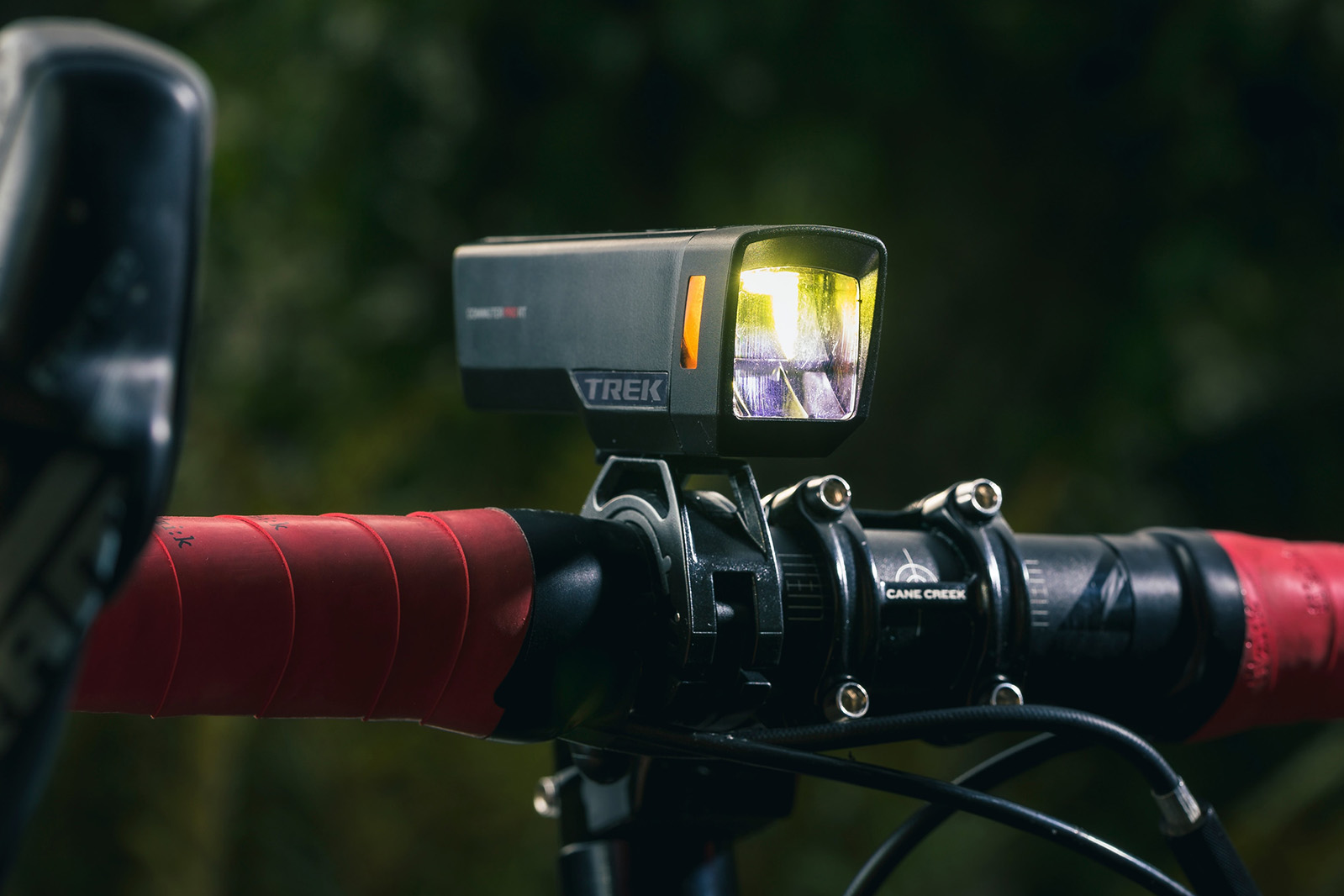
- Claimed max output: 1,000 lumens
- Run time (max power): 1 hour 30 minutes
- Pros: Kindbeam tech to avoid dazzling other road users; enough light for some gravel action
- Cons: Remote costs extra
Trek looks to mix off-road and road use with its Kindbeam tech, designed to avoid dazzling other road users (although not StVZO-compliant). It still offers 1,000 lumens for trail riders, although illumination isn’t as effective as a dedicated MTB light.
You can buy a separate remote or pair the Commuter Pro T with a Garmin cycle computer for automatic activation when you start to ride, and it’s compatible with Trek’s Blendr mounting system.
Best rear bike lights in 2023 as rated by our expert testers
Exposure TraceR DayBright rear light
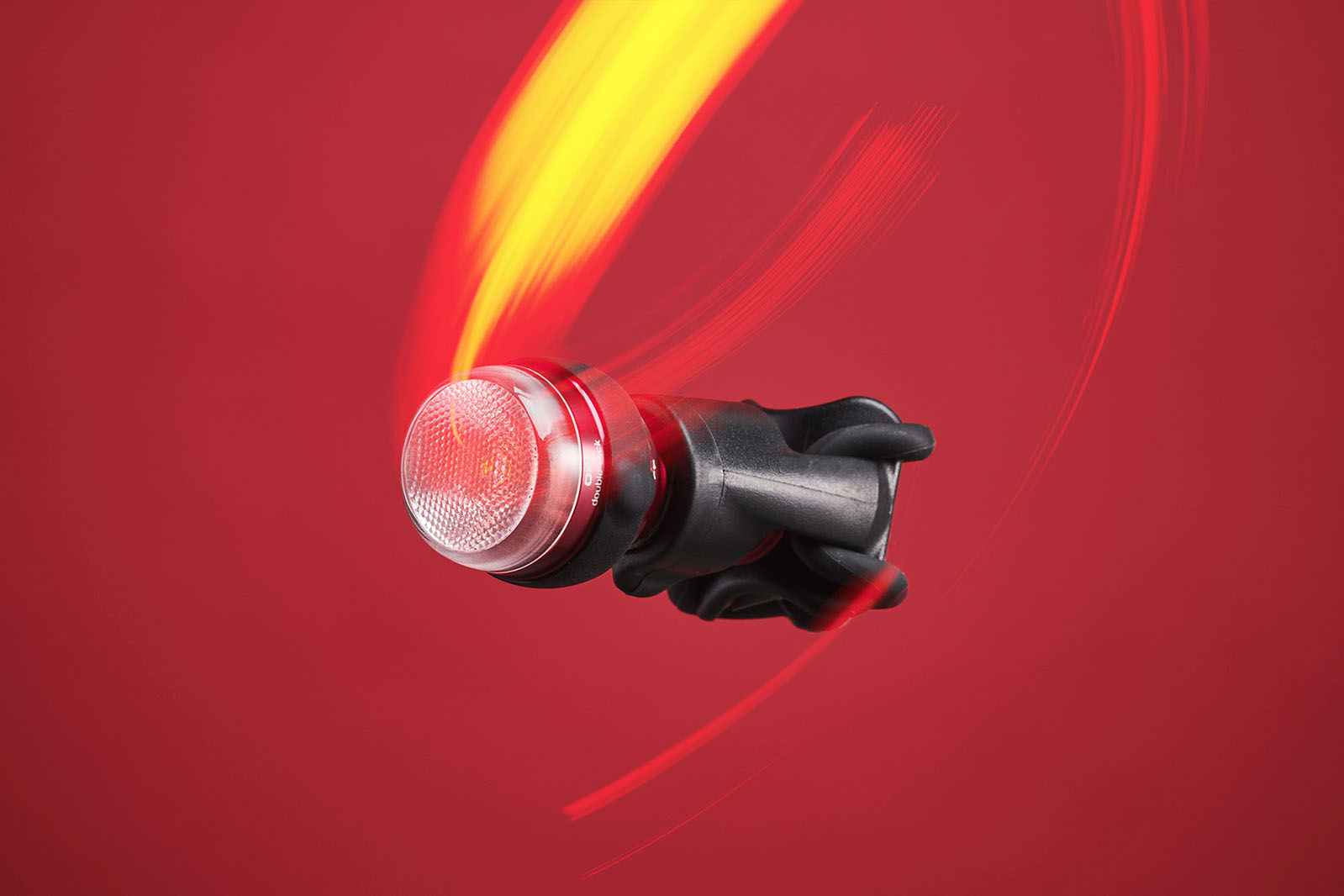
- Superb construction and durability
- Great visibility
Made from aluminium casing, a single lens and LED, the Exposure TraceR DayBright is uncomplicated and highly effective. The sturdy plastic bracket it slots into holds the light securely.
The TraceR’s bulb capitalises on all its 75-lumen max output by casting the beam 180 degrees to ensure road users see you.
It’ll last three hours in high-power mode and all day in lower settings, which are more than adequate after dark. Switching through the modes is intuitive.
Topeak Redlite Aero 1W

- 55-lumen max power setting
- Lots of mounting options
On paper, Topeak’s Redlite Aero 1W is nothing remarkable, but it’s always the one that’s ready to go and has never failed us out on a ride.
Four modes max out at 55 lumens (two-hour run time) with a low-battery indicator. Different back pieces and bands fit various shaped tubes/posts, the single LED strip is angled and it charges in two hours.
Alpkit Tau

- Mega-light 20g weight
- Long run time
Alpkit is renowned for its reasonably priced and top-performing kit, with the Alpkit Tau 20g featherweight light boasting a 20-lumen LED light strip with five modes, including high and low flash, and a constant and pulse function.
The light will run for three hours, 30 minutes on full-whack and its switch indicates the charge level.
Cateye Rapid X2

- 180-degree visibility
- Two-hour recharge time
Cateye started the LED rear light revolution and still rules in terms of reliability. Twin LED strips scroll through six modes with a 50-lumen max and 180-degree visibility.
It’s aero seatpost-friendly, but a lack of angle correction is irritating. Its light 30g weight limits max run-time to one hour, but the two-hour recharge is useful for busy riders.
Cateye has released an update called the Rapid X2 Kinetic, which detects when you brake and then brightens.
Cateye Viz450
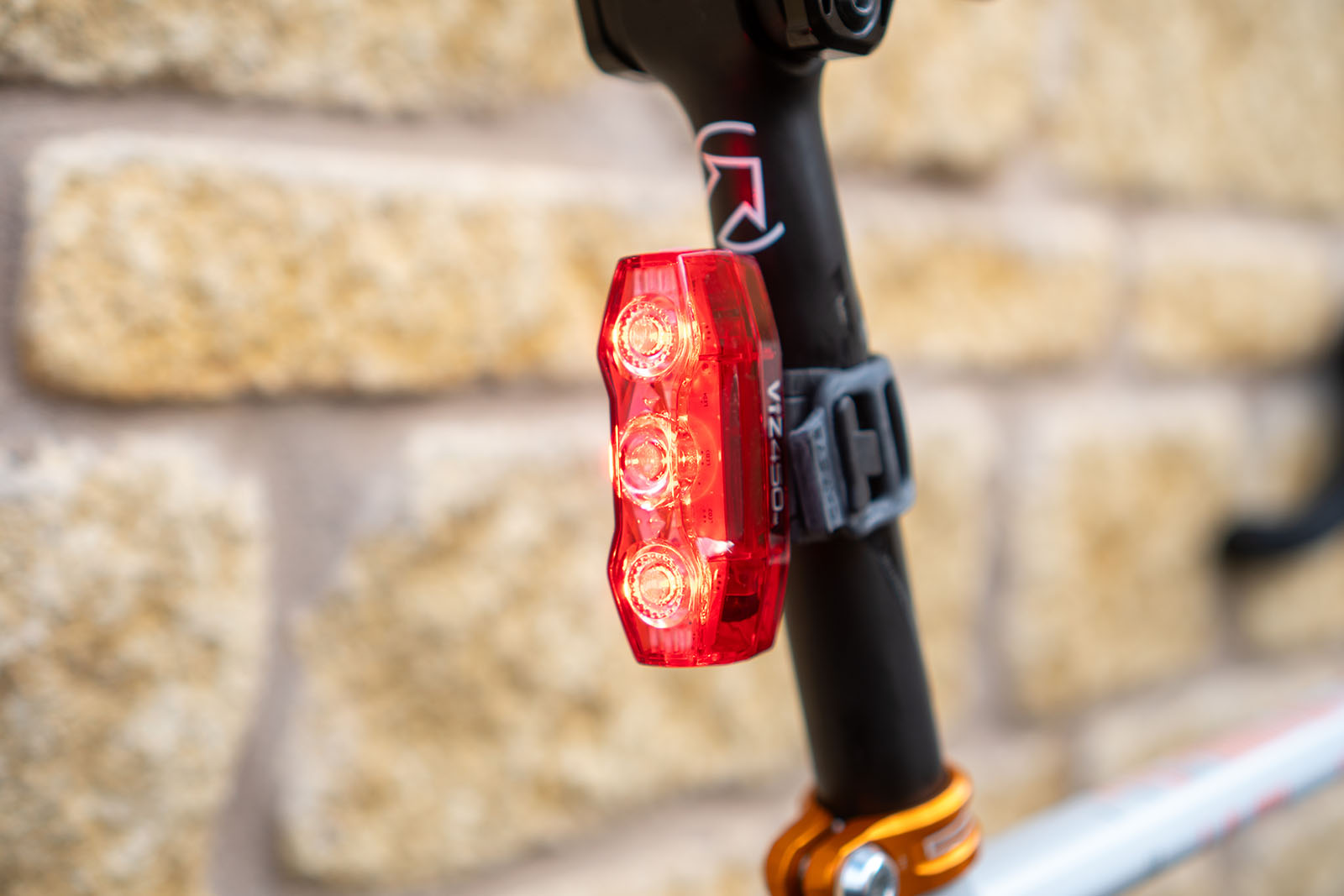
- Shock-and-awe ‘HyperFlash’ mode
- Uses Micro-USB standard for charging
Cateye’s Viz450 packs a punch in a compact unit. There are four modes to choose from, with the ‘HyperFlash’ option activating all five of the light’s LEDs, delivering 450-lumen bursts. This feature worked well in day and night settings, certainly grabbing road users’ attention, but it might not be the most pleasant experience for a driver behind in an urban setting.
You can mount the light horizontally or vertically, which is perfect if you don’t have a lot of seatpost real estate.
The light uses a Micro-USB standard for charging – a move to USB-C would be wise in a future update.
Knog Blinder Road Rear 150

- High output and nine modes to choose from
- Exposed USB connector may corrode over time
An array of COB LEDs plus a single larger strobe LED provide a large illuminated surface in the Blinder light. There are nine modes to choose from with runtimes between 2.5 hours and 50 hours.
Fortunately, there’s a memory function so the light turns on with your preferred illumination pattern.
The design includes an exposed USB connector. We’d have felt happier if this was covered to avoid it getting wet and potentially corroding. But otherwise it’s a quality package with plenty of light output.
Knog Cobber Mid

- Great side-on visibility
- Plenty of modes
As its looks suggest, the main selling point of the Knog Cobber Mid rear light is side-on visibility, and it certainly doesn’t disappoint in this regard.
Run time on full power was slightly lower than claimed by Knog, but at 1 hour 40 minutes was nevertheless good for a 75-lumen rear light.
There are a total of eight standard modes, but you can also use Knog’s Modemaker app to programme your own settings if you want something specific.
Lezyne Strip Drive Pro Alert 300

- Up to 300 lumens output
- Alert function reacts to braking
Top of Lezyne’s six-model Strip Drive range, the Alert 300 packs in a shockingly bright 300 lumens. The Alert function uses an accelerometer to up the light’s brightness when you slow down and the lens pattern gives 270-degree visibility.
There are five modes, including two constant and three flashing options. Runtimes are good, but Alert (which can’t be switched off) results in variable battery life, which can be appreciably lower in stop-start traffic than on a steady ride.
Lezyne Zecto Drive Max

- A max 250-lumen flash mode for daylight running
- Very reliable
With a versatile clip mount for straps or tubes, plus a robust construction, the ZDM is a bikepacking winner. Eight modes max out at a 250-lumen daylight flash (9-hour run time). It’s heavy (69g) and sideways visibility is limited, though.
There’s no waterproof rating, but we’ve hosed it without issue.
Magicshine Seemee V2.0

- Very bright
- Rail mount incompatible with some saddles
The Magicshine Seemee V2.0 is a bright rear light offering a maximum of 60 lumens in constant mode and 200 lumens in its day flash mode.
Despite this high output, the light is still a compact package, relatively inexpensive and has a decent run time.
The saddle rail attachment isn’t universal and dirt can get trapped in the light – so have your sponge at the ready.
Magicshine Magene Seemee 508 Radar Taillight

- Accurate vehicle detection
- Cheaper than competitors
The Magicshine Magene Seemee 508 Radar Tailight is, as the name suggests, a radar bike light. This means it can detect vehicles approaching from behind and notify you via a range of cycling computers and smartwatches.
The light does this job accurately, and at £130, it undercuts the pricier Garmin Varia.
Magicshine says the light has a 20-lumen maximum output. In reality, it feels brighter and there’s a variety of modes to help you stay seen.
The battery life isn’t the best, but if added safety is what you’re after, then it’s a good bet.
Moon Comet X-Pro
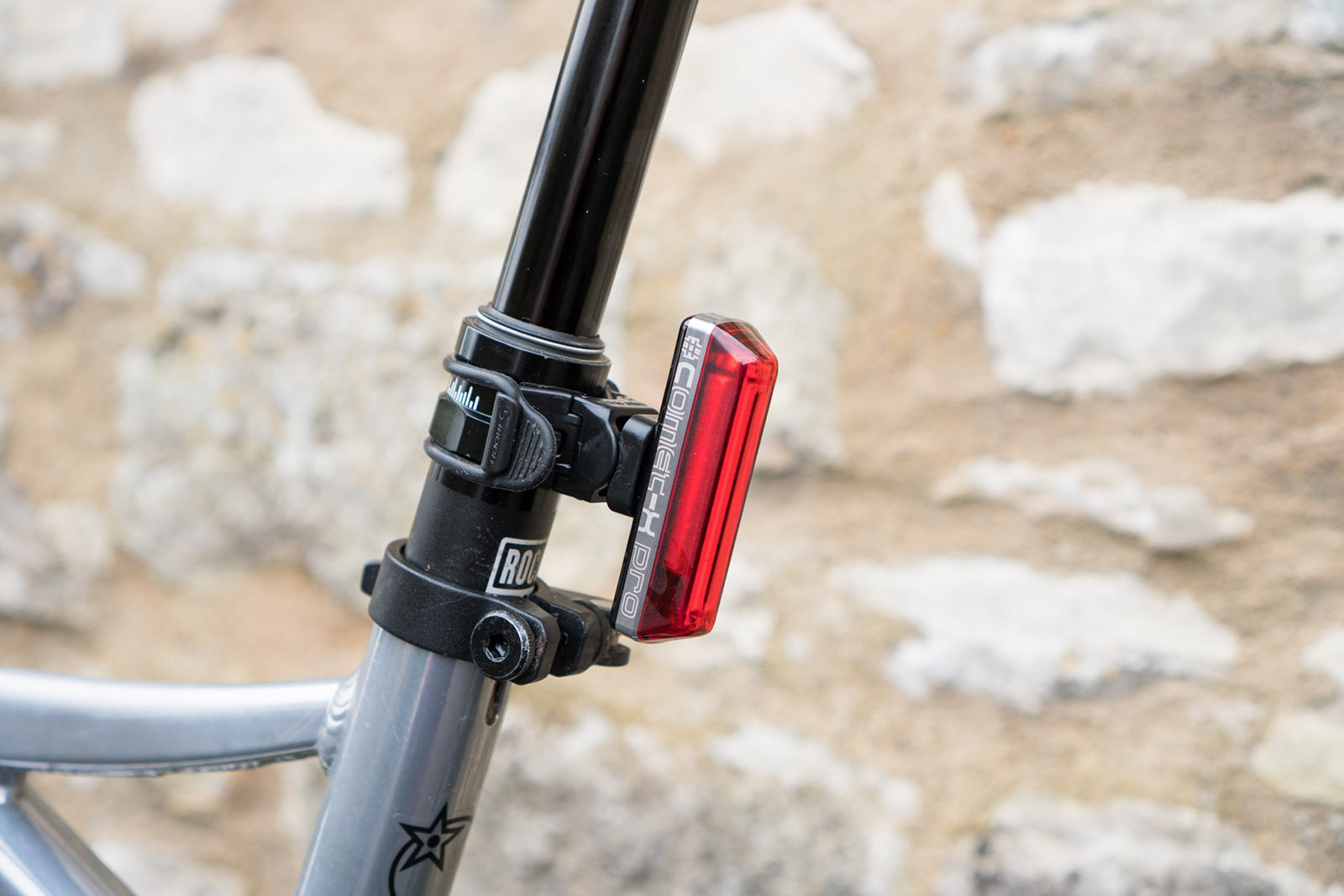
- Excellent visibility
- Lots of mounting options
Easy to fit, with lots of mounting options (including a seat rail mount, which is very good at this price), the Comet X-Pro also impresses with its intense output at full power.
Run time at full power was bang on the 1 hour 30 minutes claimed by Moon too, which is very good considering the amount of power on tap.
Unfortunately, there’s no pulse mode and it’s a little fiddly to use on the move, but the X-Pro is otherwise a very useful rear light.
NiteRider Bullet 200
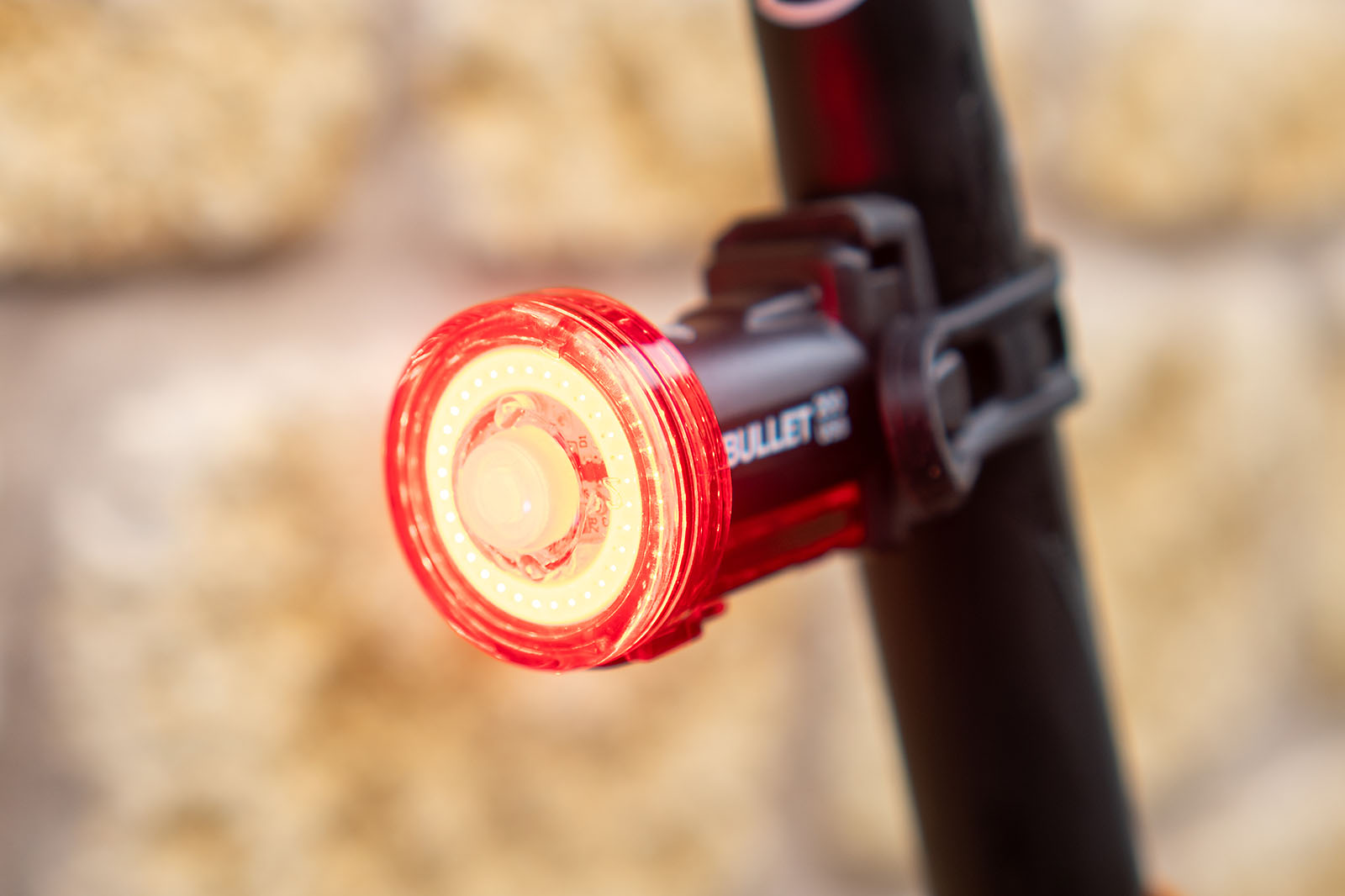
- Distinctive design
- Can shift under heavier shocks
NiteRider’s Bullet 200 may look distinctive, but the design allows for almost 360 degrees of visibility. In use, the light is easy to operate and stands out in a crowd. We appreciated the extra visibility the light casts over black bib tights.
The Micro-USB charging standard isn’t quite as up-to-date as USB-C and the light can shift slightly under heavier shocks. We think the bracket could better support the light body too.
Oxford Ultratorch R75

- Lightweight with a long run time
- No daytime modes
The Oxford Ultratorch R75 rear light is a fantastically capable performer, especially when you consider its £30 price tag.
The rear light has a long run time and is impressively bright. The shape of the light means its beam spills out from the side, which will prove particularly valuable if you’re commuting through busy city streets.
Ravemen TR500

- Easy to use and accurate battery life claims
- 500-lumen output as part of its ‘warning flash’ mode
Ravemen’s TR500 punches out up to 500 lumens as part of its ‘warning flash’ mode, with three dimmer 100, 50 and 20-lumen solid modes and two flashing modes, too. That 500-lumen mode is ludicrously bright, so care must be taken when using it to avoid distracting road users.
The light charges via USB-C, in line with the best lights.
The unit is on the large side and the bracket lacks angle compensation. However, the sheer power makes up for these flaws.
See.Sense Icon 3

- High brightness and customisable output
- Battery drains quickly in static mode
The See.Sense Icon 3 is a high-quality – and high-tech – rear bike light.
The light comes with three modes. These can be controlled via its central button or the See.Sense app. The app will let you choose between six modes and a variety of features including a braking mode and theft alarm.
The light will also gather data to learn behavioural characteristics and respond accordingly, with the light changing output based on movement and ride style. Our tester had two of these lights, one for commuting and one for club rides. The commuting light became more reactive than the club ride light, which has presumably grown used to more consistent riding.
With 350 lumens, it puts out an enormous amount of light. The payoff for this is a short run time in static mode, lasting only a few hours.
Sigma Buster RL 150
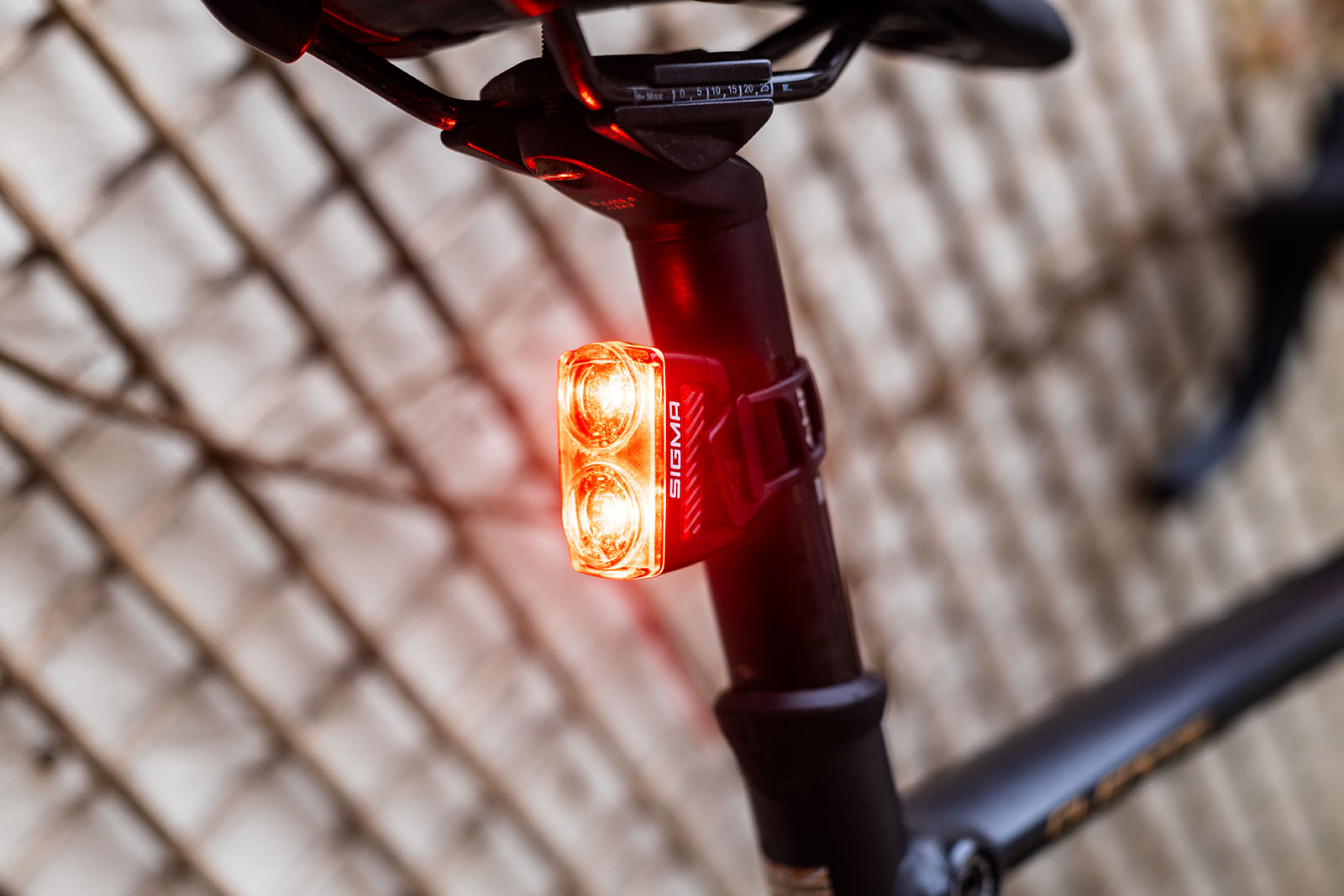
- Speed-sensing brake light
- Maximum output of 150 lumens
Sigma’s Buster RL 150 is a compact unit and mounts via a simple, flexible silicone mount. There are two solid and three flashing modes.
A built-in accelerator mode detects when you are slowing down and increases the brightness of the light.
The light lives up to its four-hour claimed run time, although our tester found it defaulted to a lower-lumen mode after three hours.
It’ll fit onto most seatposts, but the design doesn’t allow for much adjustment.
Topeak Taillux 100 USB

- Good output and ample battery modes
- Sensitive on/off button
The Topeak Taillux 100 is a bright rear light that has a decent run time. It lasted 2.5 hours in its 100-lumen mode, but our tester eked out 10 hours using the mode that alternates between blinking and constant.
It might not have any clever tech, but this is a lightweight, reliable and good-value light, which makes it a compelling option.
Best light sets for bikes 2023 as rated by our expert testers
If you know exactly what you want, then you might wish to buy a front and rear light separately. For many people, though, the lure of a good-quality light set that solves all your lighting problems in one fell swoop is hard to ignore.
Our expert testers have tested both lights that are sold as sets and separate lights from the same manufacturers that can be purchased together at a similar overall price, with a budget of around £100.
Some of the sets in this list are no longer available, but we have listed the lights individually as we still think they would make good combinations.
Bontrager Ion 200 RT front and Flare RT rear lights
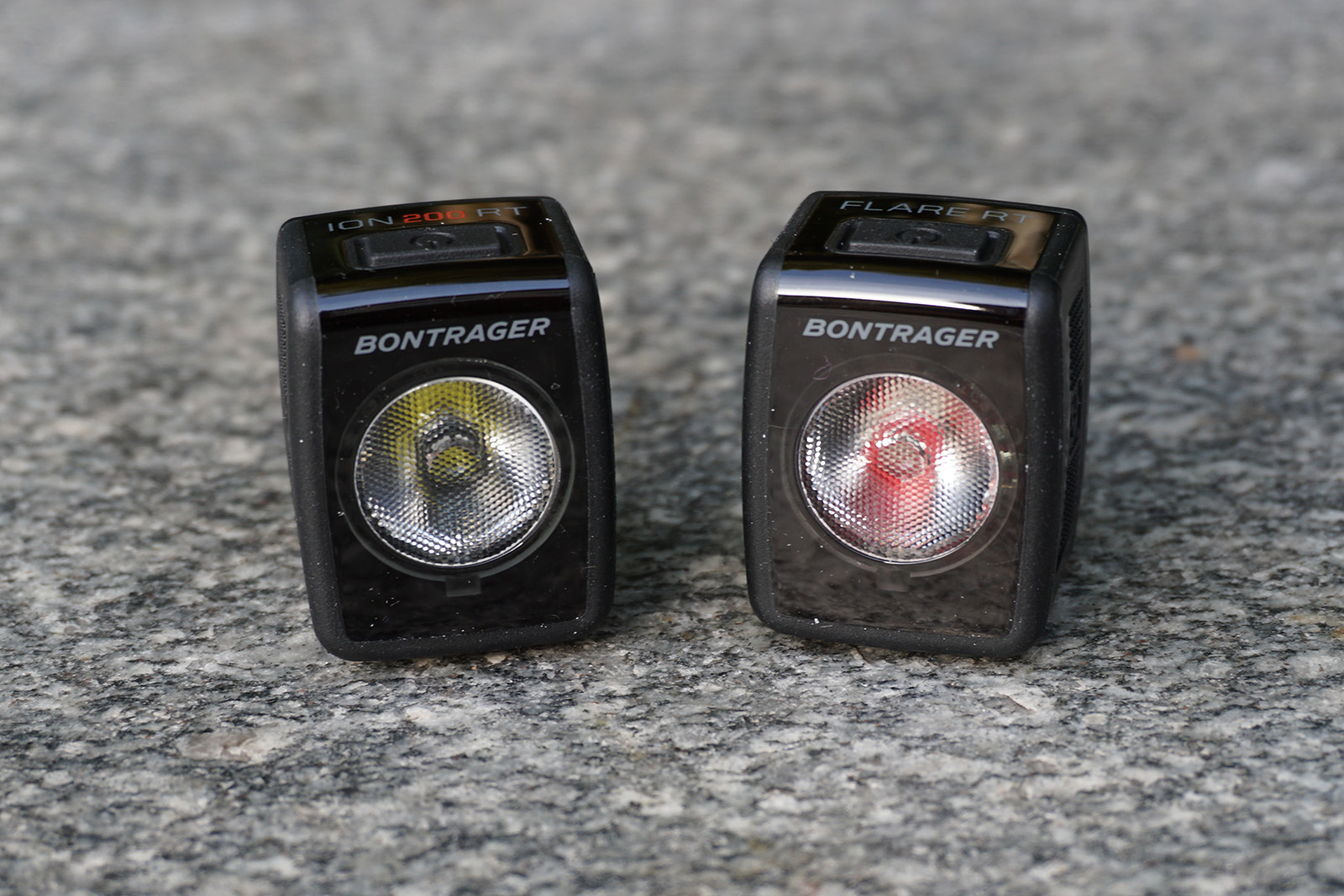
- Compact but with good runtimes
- Ambient light sensors adjust brightness to conserve battery
- Hook up to a Garmin computer for light control
These cube-shaped Bontrager lights are compact, but the front still puts out 200 lumens and the rear 90 lumens, with both lights offering flashing, constant and constant/flashing modes.
Each has an ambient light sensor to adjust brightness and you can hook them up via ANT with a Garmin cycle computer for auto on when you start to ride and to swap between modes.
Runtimes are good for such compact units and we got just under 1.5 hours for the front and 4.5 hours for the rear. The lights switch automatically to a lower output to preserve battery and give you an additional 30 minutes or so runtime.
Cateye AMPP 800 front and Cateye Rapid X3 rear lights

- Great performance and build quality
- Secure and versatile mounting systems
- 800 lumens front, 150 lumens rear at max power
Cateye has a well-earned reputation for making high-performing, good-quality lights in this category, and the AMPP 800 and Rapid X3 only serve to back this up.
The AMPP 800 has a bright, wide beam and the rear light has a clever system that uses two separate LEDs that enable you to run the light flashing and constant at the same time.
Run time at full power could be slightly better on both, but having larger batteries would naturally increase the size of the units, so it’s a bit of a trade-off.
The only slight negative is the relatively high price for the set, but they’re robust enough to provide good value in the long term.
Lezyne Lite Drive 1000XL front and Lezyne KTV Pro Drive 75 rear lights

- Versatile light set with an excellent build quality
- Bright with excellent peripheral lighting
- 1,000 lumens front, 75 lumens rear at max power
With 1,000 lumens at full power, Lezyne’s Lite Drive 1000XL provides more than enough brightness and beam spread for riding on unlit roads. You’ll only get around 80 minutes at this power, but dropping it down to the second highest output (which sits at 500 lumens) provides just under three hours of run time, which ought to be enough for even the longest of commutes.
Its CNC-machined aluminium build quality is excellent too, and its IXP7 waterproof rating is very welcome. The tough, rubber-band style mounting system makes adding/removing the lights a cinch, though they’re arguably a little less secure than ratcheted or bolt-mounted options.
The rear light puts out a slightly middling 75 lumens at full power, but does offer an impressive 270 degrees of visibility.
Ravemen PR900 front and Ravemen TR20 rear lights

- Great front light with novel design
- Remote control included in the price
- 900 lumens front, 20 lumens rear at max power
The PR900 front light is the real star of this set, offering a novel, twin-lens design and enough power to make it suitable for riding on unlit roads or even off-road.
The 900-lumen setting is more of an emergency turbo boost mode, but battery life on the 800-lumen setting is excellent, providing just over two hours of run time. It even has a USB port to allow you to use it as a battery pack to charge other gadgets (such as your phone, for example).
The rear light is sadly less impressive, packing only 20 lumens of light and a modest battery life. It’s simple and versatile, thanks to its decent mounting system, but there are brighter lights available at this price.
Buyer’s guide to bike lights | How to choose the best bike lights
How many lumens do you need?
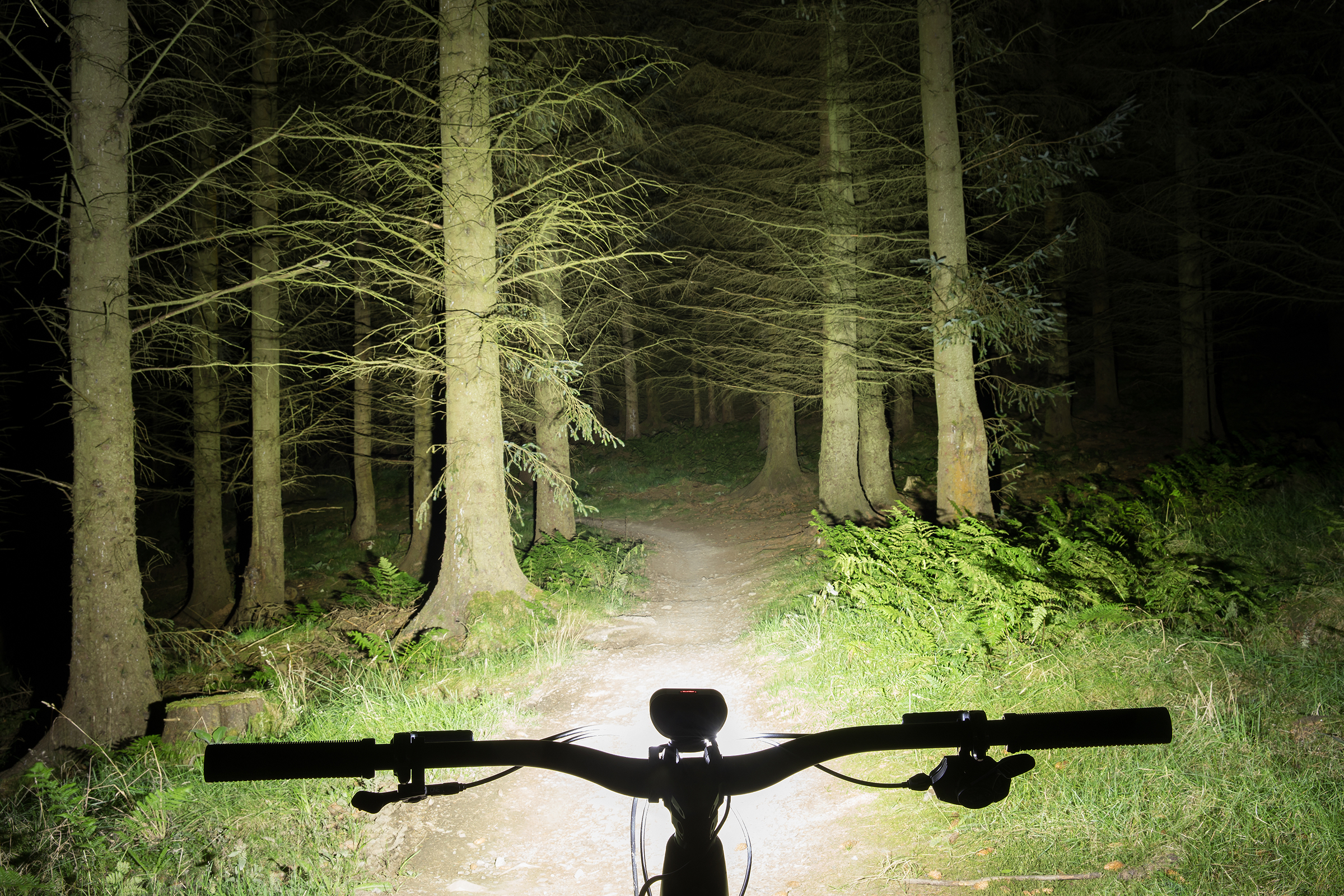
Bike lights are split into two categories: those that provide enough illumination to enable you to clearly see what’s ahead of you, and those that are designed to simply ensure that you’re seen by other road users – lights to see and lights to be seen, as it were.
Our bike light reviews are mainly focused on front lights that will enable you to see where you are going on unlit cycle paths or rural roads.
The power of a bike light is usually expressed in lumens. Lumens are the unit by which the total amount of light emitted from a source is measured.
Consequently, the amount of lumens a light offers tends to be the headline specification because a larger number essentially promises that the light will be brighter.
The power of some bike lights – usually dynamo-powered headlights and StVZO-compliant battery-powered lights – is expressed in lux. This is the measure of how much light falls on a surface.

Cyclists riding in lit urban areas, who don’t need lights to illuminate the road ahead, may only need a unit with a few hundred lumens – but if you venture on to unlit roads or paths, that’s unlikely to be enough, so you’ll need something more powerful.
For urban commuting, 200 lumens should be sufficient. We would suggest a front light with a minimum of 400 lumens for riding on unlit roads.
Don’t be fooled into thinking that the lumen rating of a bike light is the only thing that matters, though. A super-bright light that only has enough battery power to put out that headline figure for half an hour isn’t likely to be particularly useful, especially if you’ll need to use the most powerful setting for extended periods.
Make sure you check the claimed battery life at all of the various power levels to find the most suitable light for your style of riding.
It’s worth mentioning at this point that, in the UK, bike lights are not subject to any upper limit in power. Lights must be able to emit at least four candela (another unit of light intensity), which is comfortably exceeded by modern lights. Flashing bike lights are also permitted within UK law.
Are LEDs good for bike lights?

The filament bulb is thankfully a thing of the past. Virtually all of today’s high-end front lights have Cree LEDs, which offer better brightness, more versatility, less heat, longer life and are smaller.
Most rear lights now use COB LEDs. COB stands for ‘chip on board’ – essentially multiple LED chips forming a single module. They produce less heat, are brighter and can come in a variety of colours – but remember the law in most countries dictates a rear light must be red.
Battery life

Unlike mountain bike lights, which often use dedicated external battery packs, lights for road bikes and commuting usually have internal batteries, so there’s always going to be a trade-off between power, battery life and the size of the light.
For example, a more powerful light, with a longer battery life will require a physically larger battery and will therefore increase the overall size of the unit.
This isn’t necessarily a problem in itself, but many road cyclists won’t want something overly large to spoil the sleek looks of their road bike or clutter the handlebar. Likewise, some commuters will want lights that are small enough to be stuffed easily into a work bag.
For others, especially those who ride on unlit roads or enjoy particularly long rides and commutes, a larger light with more lumens and battery capacity will be essential.
What about dynamo-powered lights?
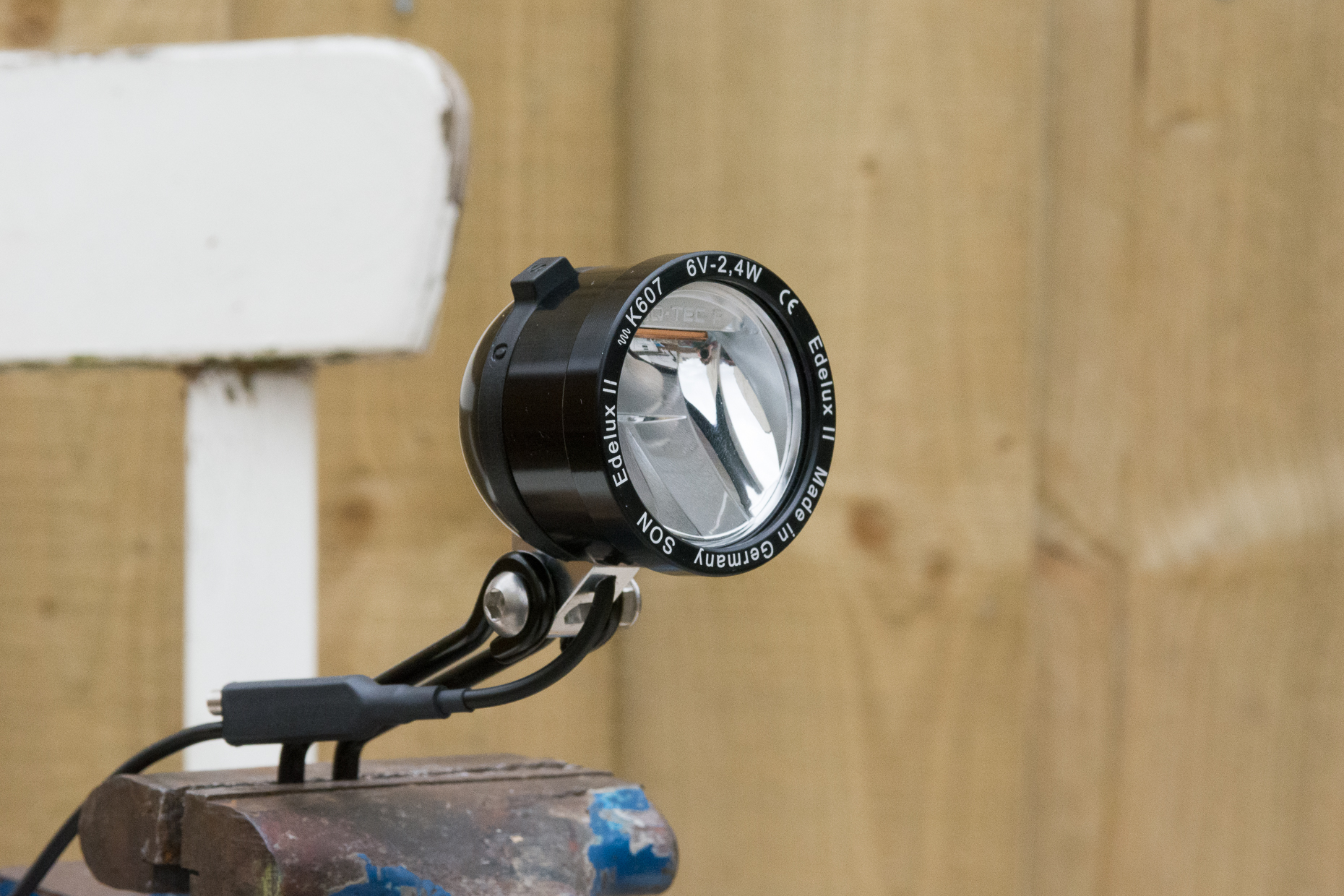
Astute readers will notice that we have only covered battery-powered lights in this guide.
Dynamo-powered lights – which, most commonly, are powered by a generator hub built into a wheel – are a very popular option on touring and town bikes, and with good reason. They offer infinite run time and the optics in the lights are often very high quality.
However, they require a significant investment in terms of both money and research, and to cover both systems would be beyond the scope of this guide. We’ve covered bike dynamos in a separate explainer, including our pick of the best dynamo lights.
Balance and beam pattern
When buying a set of lights, it’s also wise to consider the balance between the front and the rear.
The front light will almost always have much more power because its role includes lighting dark roads and cycle paths. However, while the outright lumen count of most rear lights won’t come close to the front, the spec is just as important.
A rear light’s main role is to help make you visible to other road users, so having decent brightness and battery life is essential because it needs to last the length of whatever ride you’re taking on while also being powerful enough for other road users to see it from a good distance.
Some lights are now also marketed for daytime use, with the appropriate brightness and flash patterns to help keep you seen in bright sunshine and low light.
Both front and rear lights should also balance range and peripheral lighting. A highly focused beam can be great for lighting the road in front of you for fast riding, but for the sake of both being able to spot hazards and to enable road users approaching from different angles to see you better, it’s important that some of the light beam spreads into the periphery as well.
What about StVZO lights?

StVZO bike lights conform to German Road Traffic Licensing Regulations, with beam patterns shaped to avoid dazzling other road users.
You don’t need to use StVZO-approved lights anywhere other than on German roads – however, if you ride solely on the road, investing in a StVZO light could be a good idea.
The narrow beam might not suit mountain bikers or bikepackers cycling at night, but there are more StVZO light options becoming available that let you change between high and low beams to get around this issue.
Mount systems

In an ideal world, you would be able to have a mounting system that is perfectly simple, lightning-quick to install and remove, totally secure and infinitely durable… But in reality, there’s usually a bit of a compromise between those various characteristics.
The simplest mounts use heavy-duty rubber bands and dedicated grooves on the light mount. These systems have the advantage of being extremely quick and easy to install and remove, and can usually be easily adjusted to different types and sizes of handlebar, seat posts, etc.
On the other hand, it’s easy to lose these elastic bands when the lights aren’t mounted on the bike and they’re more susceptible to movement over rough ground. Given long-term use, they’re also more likely to degrade and eventually break than a solid mount.

Solid plastic or metal mounting systems, which clip on to the handlebars and are secured with bolts, tend to offer much better security on bumpy roads as well as much greater long-term durability.
Installing or removing these types of mounts can often be a much more involved process though, sometimes even requiring a specific tool (such as a small hex key).
Usually, manufacturers will look to mitigate this inconvenience by making the light separately removable from the actual mount itself (so, for example, you can quickly take the light unit with you after locking up your bike), but not every light offers this function, so it’s worth checking before you buy.
Gravel bike lights

If you’re looking for a set of bike lights for gravel riding there are several things to keep in mind.
A gravel bike light should be more powerful than a road bike light to illuminate unlit trails and gravel paths. For gravel riding, it’s unlikely you’ll need the same amount of power as a mountain bike light because you’ll only really need to light the path in front of you rather than twisting and turning trails.
Having said that, you may prefer a light for your gravel bike with a wider beam than a road bike light, because you’ll still likely be coming across more obstacles than you would on a road ride.
We’d recommend a front light with a minimum of 600 lumens. You may prefer a gravel bike light with more power than this if you prefer technical gravel riding and taking your bike down the odd section of singletrack. Some of the 2,000-lumen lights in this list may prove a worthwhile – if not pricy – investment.
A rear light for gravel riding should also be powerful. Riding on dark roads will mean your rear light will have to do more to keep you safe and seen.
Other features
Waterproofing is important, particularly if you regularly ride in poor weather conditions. The IP Code is a measurement of protection against the ingress of water and dust. IP4 protects against splashing of water, while an IP7 product will survive immersion in water for 30 minutes.
Some front lights not only power their own LEDs but have USB ports that allow you to charge mobiles or GPS computers – particularly useful for long-distance riders.


